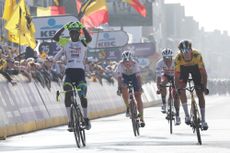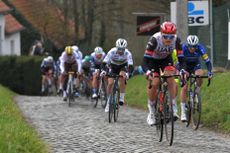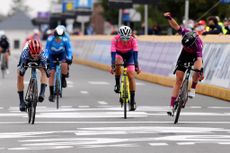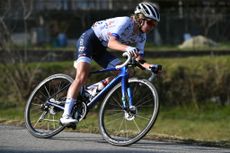'Physical block' the only way to stop riders using paths instead of cobbles
Riders have always looked to find away the rough cobbles of the Classics, and organisers are struggling to stop them

Riders use the path instead of the cobbles in the 2015 Kuurne-Brussels-Kuurne (Watson)

Classics organisers must "physically block" cyclists from avoiding the cobbled roads for the smooth shoulders because it "is the only solution," say teams.
The UCI issued a 200 Swiss Franc fine to each of the 15 cyclists in the lead group, including eventual winner Philippe Gilbert (Quick Step Floors), in the Three Days of De Panne's first stage on Tuesday. They had avoided the cobbles in favour of the smooth sidewalk ahead of the Berendries.
>>> Let’s end confusion over the interpretation of road racing’s rules
In another incident, Marco Haller (Katusha) cut through the inside of a curve in Geraardsbergen ahead of the Muur. Though he was still riding on cobbles, he nearly ran into a spectator.
"I know, I was a former rider. If the area is open, the riders will take it," Lotto-Soudal sports director, Frederik Willems told Cycling Weekly.
"It's up to the UCI and the organisation to block the roads. Besides the Tour of Flanders, the shoulder is never blocked on the climbs. Why do they block it in Flanders and not the other races? We need to physically block them, that is the only solution."
The UCI introduced new rules for 2014 prohibiting riding "off-road" after several incidents with spectators.
Get The Leadout Newsletter
The latest race content, interviews, features, reviews and expert buying guides, direct to your inbox!
Inconsistency helped give way to confusion and rogue cyclists. In the recent Omloop Het Nieuwsblad, critics bashed the lead group with Greg Van Avermaet, Peter Sagan and Sep Vanmarcke for riding on the pavement instead of the cobbles.
"If they see Greg and Peter on the paths and they don't get punished, the riders think, why should we not also do it?" added Willems. "There is only one solution, blocking the path next to the cobblestones."
Watch: How to ride on cobbles
"They give all the men in the breakaway fines yesterday, but then you see the main group doing the same and they are not punished," said Quick-Step Sports Director Rick Van Slycke. "And there were other incidents gone unpunished, like when riders were pacing behind cars after the Muur to rejoin.
"To control all of it you need many race commissioners on motorbikes, and it becomes impossible to have so many men and to police everything.
"When they go on the sidewalks with people then I think they should be fined because that's not allowed and it's not good. Barriers? Yes, but that's not possible for them to do everywhere."
Italian Filippo Pozzato (Wilier-Selle Italia) had not realised that the jury fined his colleagues for riding on the sidewalk. Regardless, he said that he does not do so.
"Why do they do it? Because they're stupid!" he said with a laugh.
"The UCI has its new rule in the last two years says that you can't ride on sidewalks, but everybody goes on them and they never give a fine, so it serves very little.
"Some go over the roundabout. If you're going over the roundabout then you need to be disqualified, otherwise the rules serve nothing."
Trucks carrying racks of barriers rolled westwards down the E40 motorway yesterday evening to prepare for the Three Days of De Panne's second stage today. It is an "impossible" solution to put them everywhere, however.
"The rider's they will try to pass anywhere. It's impossible to put barriers everywhere. Some riders are just stupid and they go anywhere and risk everything all the time," continued Pozzato.
"The rule has to be followed, otherwise there's no point having a rule."

Thank you for reading 20 articles this month* Join now for unlimited access
Enjoy your first month for just £1 / $1 / €1
*Read 5 free articles per month without a subscription

Join now for unlimited access
Try first month for just £1 / $1 / €1
Gregor Brown is an experienced cycling journalist, based in Florence, Italy. He has covered races all over the world for over a decade - following the Giro, Tour de France, and every major race since 2006. His love of cycling began with freestyle and BMX, before the 1998 Tour de France led him to a deep appreciation of the road racing season.
-
 Among market turmoil, Colnago boasts €55 million in sales: CEO shares the brand’s secret
Among market turmoil, Colnago boasts €55 million in sales: CEO shares the brand’s secretColnago’s growth has tripled since the brand’s acquisition by new majority stakeholders in 2020 and seems impervious to the downturn. Here's why.
By Anne-Marije Rook Published
-
 Why e-bike torque numbers matter more than you think
Why e-bike torque numbers matter more than you thinkYou should choose an e-bike based on torque, not just power
By Paul Norman Published
-
 Biniam Girmay takes momentous sprint victory at Gent-Wevelgem
Biniam Girmay takes momentous sprint victory at Gent-WevelgemThe Eritrean etched his name in history as the first African rider to win the spring classic.
By Tom Davidson Last updated
-
 How to watch Omloop Het Nieuwsblad 2022: Live stream the first cobbled Classic of the season
How to watch Omloop Het Nieuwsblad 2022: Live stream the first cobbled Classic of the seasonIf you can't be in Belgium for Opening Weekend you might as well watch it on the TV
By Jonny Long Published
-
 Trek-Segafredo back to winning ways as Ruth Winder takes Brabantse Pijl
Trek-Segafredo back to winning ways as Ruth Winder takes Brabantse PijlUS national champion Ruth Winder won the tightest of sprints at Brabantse Pijl on Wednesday (April 14).
By Owen Rogers Published
-
 Lorena Wiebes wins in a bunch sprint at a wind ravaged women's Scheldeprijs
Lorena Wiebes wins in a bunch sprint at a wind ravaged women's ScheldeprijsTeam DSM win the battle of the lead outs after a scrappy final in the Belgian wind and rain
By Owen Rogers Published
-
 Groupama-FDJ pull out of Scheldeprijs 2021 after Covid-19 positive
Groupama-FDJ pull out of Scheldeprijs 2021 after Covid-19 positiveGroupama-FDJ have had to pull out from racing at the Belgian one-day race of Scheldeprijs due to a positive Coronavirus test within the team
By Tim Bonville-Ginn Published
-
 Annemiek van Vleuten wins the Tour of Flanders with a signature long range move
Annemiek van Vleuten wins the Tour of Flanders with a signature long range moveAnnemiek van Vleuten won the Tour of Flanders for the second time with a signature attack on Sunday.
By Owen Rogers Published
-
 Tour of Flanders 2021 start lists
Tour of Flanders 2021 start listsFull list of riders taking part in the 2019 edition on Sunday, April 7
By Jonny Long Published
-
 'Risk big and you win big,' Cecilie Uttrup Ludwig willing to risk all at the Tour of Flanders
'Risk big and you win big,' Cecilie Uttrup Ludwig willing to risk all at the Tour of FlandersAfter finishing third in 2019 the Danish rider has a stronger team than ever to help achieve a first WorldTour win
By Owen Rogers Published